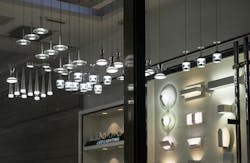Final Version of DesignLights Consortium’s New Technical Requirements for LED Lighting Released
Key Takeaways
- The new technical requirements combine SSL V6.0 and LUNA V2.0 into a single, streamlined set of standards effective January 2026.
- Major revisions include higher efficacy thresholds for premium luminaires and expanded support for advanced controls and flexible installation practices.
- Qualified products will remain on the list until December 2026, providing a transition period for manufacturers and users.
The DesignLights Consortium (DLC) released in final form the first major update to its Solid-State Lighting (SSL) technical requirements in over five years, as well as revisions to the Light Usage for Night Applications (LUNA) program, a DLC program to mitigate light pollution through responsible outdoor lighting.
The new technical requirements reflect comments the DLC received over the past year, beginning with a call for feedback on proposed updates in the fall of 2024 and continuing with two six-week public stakeholder comment periods since the first draft was released in March 2025. In that time, the DLC received nearly 1,400 comments from over 50 organizations.
Formerly two separate policies, the SSL V6.0 and LUNA V2.0 Technical Requirements are now combined in a single set of technical requirements and scheduled to take effect in January 2026. While the DLC will begin accepting applications under the new technical requirements on January 5, previously qualified products will not be removed from the SSL and LUNA Qualified Products Lists (QPL) until December 2026.
“It’s been five years since the DLC last updated our specifications and, in that time, the market has matured and lighting technology has advanced,” said DLC Executive Director and CEO Tina Halfpenny. “Our SSL V6 and LUNA V2 requirements reflect years of collaboration with efficiency programs, manufacturers, and lighting experts. These updates simplify tools for program administrators, create value for manufacturers through consistent, streamlined processes, and extend the runway for programs to save energy, reduce emissions, and mitigate light pollution - advancing a smarter, more sustainable lighting future.”
The DLC technical requirements define performance thresholds for its QPLs, which are used by 75% of North American energy efficiency programs to identify high-quality, energy efficient commercial lighting solutions eligible for rebates and incentives. The SSL V6.0/LUNA V2.0 technical requirements are bold where it counts, practical where it matters and designed to drive lasting impact.
Key updates to SSL V6.0 include:
- A major revision to the DLC Premium product classification for luminaires with higher efficacy thresholds and more rigorous requirements for controllability, expanding the classification to further enable incentives for advanced controls and integrated building systems.
- Provisions to drive wider adoption of controls through compatibility-based product selection from the SSL and Networked Lighting Controls (NLC) QPLs.
- Expanded SSL QPL eligibility to support sustainability, lighting innovation and flexible installation practices.
- Clear criteria and improved documentation for manufacturers and specifiers.
Full details of SSL V6.0 and LUNA V2.0 are available the DLC’s website and additional context can be found on the DLC blog. For more information, register for the DLC’s webinar on Wednesday, Nov. 12 at 3 PM EST.
